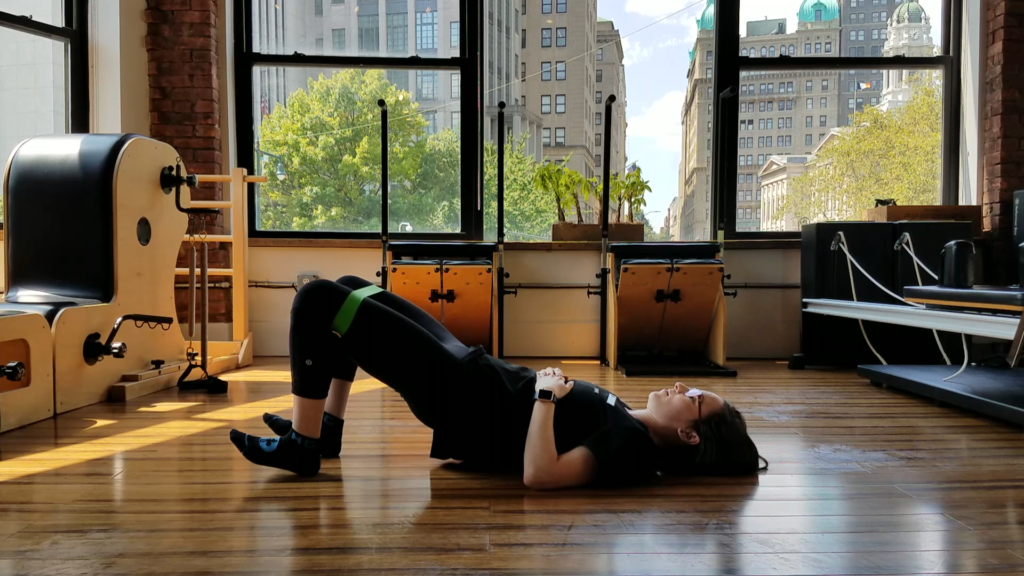Physio Logic’s Chiropractor & Acupuncturist, Dr. Allison Heffron, shares some effective exercises to help strengthen important muscle groups related to hip stability. Practicing these exercises frequently will prevent injury and improve overall balance.
IMPORTANT NOTE: Although these are being demonstrated and instructed it is not advised to perform these unless you have been prescribed these exercises especially if you are experiencing pain. If performing these on your own and you feel pain during any point please stop immediately.
Banded Glute Bridge (Double Leg and Single Leg)
Glutes. Do 3 Sets of 8 Reps.
Why this exercise works to reduce pain:
This exercise requires glute and core stability, which work synergistically to take pressure off of low back from overcompensating.
Advanced Banded Glute Bridge with Yoga Ball
Glutes primarily and hamstrings. Do 3 Sets of 8 Reps.
Why this exercise works to reduce pain:
This exercise requires glute and core stability, which work synergistically to take pressure off of low back from overcompensating.
Advanced Banded Glute Bridge with Sliders
Glutes primarily and hamstrings. Do 3 Sets of 8 Reps.
Why this exercise works to reduce pain:
This exercise requires glute and core stability, which work synergistically to take pressure off of low back from overcompensating.
Hip Hinge First Progression
What muscle groups are being activated for each exercise:
Glutes, Lateral Hip Stabilizers, and Core. Do 10 reps for 3 sets.
Why this exercise works to reduce pain:
This exercise focuses on glute and core activation to keep the spine neutral (no excessive bending from spine).
Hip Hinge Second Progression
What muscle groups are being activated for each exercise:
Glutes. Do 10 reps for 3 sets.
Why this exercise works to reduce pain:
This exercise focuses on glute and core activation to keep the spine neutral (no excessive bending from spine).
Hip Hinge Third Progression
What muscle groups are being activated for each exercise:
Glutes and Lateral Hip Stabilizers, and Core. Do 10 reps for 3 sets. You should practice anytime throughout the day especially when bending over to reach/pick something up from ground.
Why this exercise works to reduce pain:
This exercise focuses on glute and core activation to keep the spine neutral (no excessive bending from spine).
Shin Box First Progression
What muscle groups are being activated for each exercise:
This stretch will focus on relaxing hip muscles. Sit in position on each side until muscles have relaxed (can be anywhere from 30 seconds to 2 minutes).
Why this exercise works to reduce pain:
This exercise helps to mobilize stiff and restricted hips in two different directions, simultaneously, internal and external rotation.
Shin Box Second Progression
What muscle groups are being activated for each exercise:
Primarily Glutes with some activation of the Quads. Do 8 reps for 3 sets.
Why this exercise works to reduce pain:
This exercise allows control over hips and brings awareness to hip joints and hip musculature. If you are aware of an area, then you can control the area, which results in less pain.
Banded Micro Monster Walk
What muscle groups are being activated for each exercise:
Lateral Hip Stabilizers (sides of butt) and Core. Take 10 steps in each direction 3 times.
Why this exercise works to reduce pain:
This exercise requires glute and core stability, which work synergistically to take pressure off of low back from overcompensating.
Skier’s Jump
What muscle groups are being activated for each exercise:
Lateral Hip Stabilizers. Do 5 reps for 3 sets.
Why this exercise works to reduce pain:
Plyometric (aka ballistic) fast twitch muscle fibers is an advanced progression to work on once skilled in controlling those joints in slow and controlled fashion. This exercise is only performed when no longer feeling pain.
